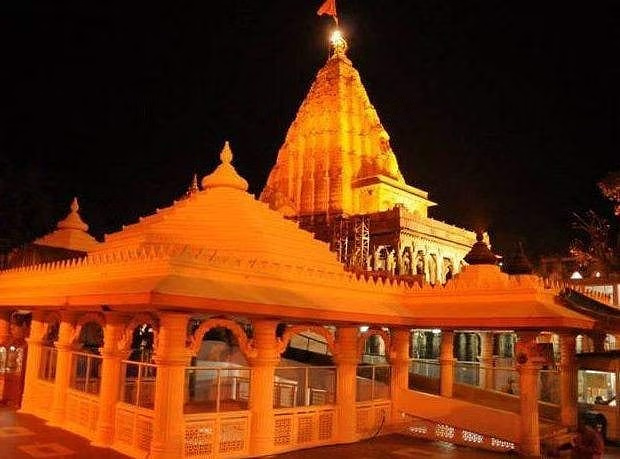In the serene Kangra Valley of Himachal Pradesh lies one of India’s most revered Shaktipeeths — the Nagarkot Temple, also known as Shri Bajreshwari Devi Temple or Kangra Devi Temple. The ancient name of Kangra was Nagarkot, and the temple’s spiritual and historical significance draws thousands of devotees and tourists every year.
Nestled amidst the majestic Dhauladhar mountains, the Nagarkot Temple is dedicated to Goddess Bajreshwari, an incarnation of Shakti — the primordial feminine energy. Pilgrims visit to seek blessings, find inner peace, and experience the divine aura of this holy place.
This article explores the history, mythology, significance, architecture, rituals, festivals, travel tips, and FAQs — everything you need to know about visiting the sacred Nagarkot Temple.
Table of Contents
Mythological Significance of Nagarkot Temple
The Nagarkot Temple is one of the 51 Shaktipeeths, where parts of Goddess Sati’s body are believed to have fallen during Lord Shiva’s grief-stricken dance of destruction — the Tandava.
The Story of Shaktipeeths
According to Hindu mythology:
Goddess Sati immolated herself at her father Daksha’s yajna when he insulted her husband, Lord Shiva.
Enraged and heartbroken, Shiva carried her burning body and wandered across the universe.
To stop his destructive grief and restore cosmic balance, Vishnu used his Sudarshan Chakra to cut Sati’s body into 51 pieces, which fell at different places on Earth.
At Nagarkot, it is believed that Sati’s left breast fell, symbolizing the Mother’s nurturing and sustenance. Hence, she is worshipped here as Bajreshwari or Kangra Devi.
History of Nagarkot Temple
Ancient Name and Legacy
The ancient name of Kangra was Nagarkot, which means “fortified city of the serpent (Nāga).” The area has a rich history, and the temple itself is mentioned in ancient texts like the Mahabharata and the Puranas.
Pandava Connection
According to legend, the Pandavas visited this shrine during their exile and built a small temple to honor the goddess and seek her blessings.
Medieval Wealth and Invasions
The temple was adorned with gold and precious jewels over centuries by kings and devotees.
In 1009 CE, Mahmud of Ghazni plundered the temple, looting its vast treasures.
Despite repeated attacks, the temple remained a center of faith and devotion.
Earthquake and Rebuilding
A devastating earthquake in 1905 destroyed much of the temple, but it was rebuilt with the support of the local community, preserving its sanctity.
Today, the temple stands as a symbol of faith, resilience, and divine grace.
Architectural Beauty of Nagarkot Temple
The Nagarkot Temple exemplifies traditional North Indian temple architecture with striking features:
Key Highlights:
- Ornate entrance adorned with carvings and mythological motifs
- Elegant shikhara (spire) rising above the sanctum
- Spacious courtyard with diyas (lamps) and prayer areas
- Inner sanctum with the idol of Bajreshwari Devi, beautifully decorated with flowers, silk, and jewelry
- Smaller shrines dedicated to other deities within the complex
The temple offers a blend of spiritual ambiance and artistic grandeur.
Spiritual Importance
Visiting the Nagarkot Temple is considered spiritually rewarding and transformative. Devotees believe that worshipping here can:
- Remove obstacles and negative energies
- Bless with health, wealth, and happiness
- Fulfill sincere wishes and prayers
- Grant fertility and protect mothers and children
The goddess here is revered as a nurturing mother who protects and sustains her devotees.
Rituals and Festivals
The temple is alive with vibrant rituals and celebrations throughout the year.
Daily Rituals:
Mangala Aarti (early morning): Waking and adorning the goddess
Bhog (midday): Offering food to the deity and distributing prasad
Shayan Aarti (night): Preparing the goddess for rest
Major Festivals:
Navratri
Navratri (both Chaitra and Sharad) is the most significant festival here. The temple is decorated beautifully, and thousands of devotees flock to seek blessings.
Makar Sankranti
On Makar Sankranti, butter is applied to the goddess’s idol to heal the wounds she suffered during her mythical battle with demons. This unique ritual attracts many devotees.
Other Festivals
Other Hindu festivals like Diwali, Dussehra, and Janmashtami are also celebrated with devotion and joy.
Temple Timings
| Season | Morning | Evening |
|---|---|---|
| Summer | 5:00 AM – 12:30 PM | 1:30 PM – 10:00 PM |
| Winter | 6:00 AM – 12:30 PM | 1:30 PM – 9:30 PM |
Note: Timings may vary during festivals or special occasions. It’s advisable to check locally before visiting.
How to Reach Nagarkot Temple
Located in Kangra, Himachal Pradesh, the temple is easily accessible by air, rail, and road.
By Air:
Nearest Airport: Kangra Airport (Gaggal) — approx. 14 km
Flights are available from Delhi and Chandigarh.
By Train:
Nearest narrow gauge station: Kangra Mandir
Nearest broad gauge station: Pathankot — about 90 km
By Road:
Well-connected to Delhi (460 km), Chandigarh, Amritsar, and Dharamshala.
Regular buses, taxis, and private vehicles are available.
Best Time to Visit
The temple is open throughout the year, but the best time is during the cooler months:
- October to March: Pleasant weather and festive season
- During Navratri and Makar Sankranti: To experience the vibrant celebrations
Avoid peak summer if you are not comfortable with high temperatures.
Where to Stay
Kangra and nearby Dharamshala offer a range of accommodations:
Budget guesthouses and dharamshalas near the temple
Mid-range hotels in Kangra town
Luxury and boutique resorts in Dharamshala and McLeodganj
It is recommended to book in advance during festivals.
Nearby Attractions
Make the most of your visit by exploring other attractions around Kangra:
1. Kangra Fort
One of the oldest forts in India, with breathtaking views and historical significance.
2. Masroor Rock Cut Temples
Fascinating monolithic temples, also called the “Ellora of Himachal.”
3. Dharamshala & McLeodganj
Known for Tibetan culture, monasteries, and serene landscapes.
4. Baijnath Temple
An ancient Shiva temple about 50 km from Kangra.
Devotee Testimonials
Many devotees share touching stories of healing, miracles, and inner peace experienced at Nagarkot Temple. From fulfilled wishes to overcoming hardships, countless pilgrims testify to the goddess’s grace and blessings.
Travel Tips for Devotees
- Wear modest clothing suitable for a temple visit.
- Remove shoes before entering the temple premises.
- Carry cash for offerings, as digital payments may not be accepted everywhere.
- Respect local customs and maintain silence in the sanctum.
- Be prepared for crowds during festivals.
Interesting Facts About Nagarkot Temple
It is believed to be the site where Goddess Sati’s left breast fell, making it a powerful Shaktipeeth.
Once adorned in gold, the temple was famously looted by Mahmud of Ghazni in the 11th century.
The butter application ritual on Makar Sankranti is unique to this temple.
Despite invasions and earthquakes, the temple remains a vibrant center of faith.
FAQs About Nagarkot Temple
Q1: Why is it called Nagarkot Temple?
The ancient name of Kangra was Nagarkot, meaning “city of the serpent (Nāga).” Hence, the temple is also known by this name.
Q2: Is Nagarkot Temple a Shaktipeeth?
Yes, it is one of the 51 Shaktipeeths, where Goddess Sati’s left breast fell.
Q3: What is the best time to visit Nagarkot Temple?
October to March is ideal due to pleasant weather, with special significance during Navratri and Makar Sankranti.
Q4: How far is Kangra from Dharamshala?
Kangra is about 20 km from Dharamshala and can be reached easily by taxi or bus.
Q5: Are non-Hindus allowed to visit the temple?
Yes, visitors of all faiths are welcome, provided they maintain decorum and respect the sanctity of the site.
Q6: Are photography and videography allowed?
You may take photos in the outer areas, but restrictions may apply in the inner sanctum. Always check with temple staff.
Q7: Are accommodations available nearby?
Yes, a variety of hotels, dharamshalas, and lodges are available in Kangra and Dharamshala.
Conclusion
The Nagarkot Temple, also known as Shri Bajreshwari Devi Temple, stands as a beacon of faith, devotion, and resilience. Rooted in mythology and enriched by centuries of worship, it continues to draw pilgrims and travelers from all corners of the world.
Whether you come to seek blessings, experience its divine energy, or marvel at its history and architecture, the Nagarkot Temple promises a spiritually fulfilling journey.
Bow your head before Bajreshwari Mata, who nurtures her devotees with love and compassion. Let the sacred aura of this Shaktipeeth fill your heart with peace and positivity.
Have you visited the Nagarkot Temple? Share your experiences or ask your questions in the comments below!











